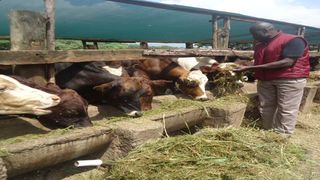Breaking News: KDF chopper crash kills five

Thomas Onono, a livestock officer, feeds beef animals at Mazao Farm in Kisumu in 2015. Animals kept under zero-grazing system produce less greenhouse gasses.
Seeds of Gold
Premium
How livestock keepers can help curb greenhouse gas emissions
As demand for milk surges, with estimates showing that it would increase 85 per cent by 2050, there is concern of a rise in emission of greenhouse gases (GHG). The over 4.6 million dairy cattle in the country account for 15 percent of total GHG emissions.
For the country to meet its target of 32 per cent GHG emission reduction by 2030, the over 600,000 dairy farmers must do their part to reduce the carbon footprint (CF), which is the total amount of GHGs that are produced through human activities.
These gasses include carbon dioxide (CO2), nitrous oxides (N2O) and methane (NH4). High levels of the gasses in the environment lead to rising temperatures, a condition known as global warming, which is synonymous with climate change.
A 2020 study found that the CF from the dairy sector is between 2.19 and 3.13kg CO2e per kilo fat and protein corrected in milk, which is way beyond the maximum of 2.15 in developed countries. Further, the same study indicated that 55 per cent of GHGs in the dairy cattle came from fermentation of feed materials in the digestive system (enteric fermentation), followed by feed production and transportation (31.6 per cent) and manure (12.6 per cent). Addressing these three areas will be key in climate change mitigation.
Here is what farmers can do:
Enteric fermentation
Methane (CH4) gas is one of the by-products of feed digestion by ruminant animals such as cattle, sheep and goats. The gas is expelled from the animal’s body through belching as it regurgitates feed. It also comes out during defecation. Some of the things that affect the amount of methane that is released by an animal are the feeding system, level and quality of the consumed feeds, size, growth rate, level/quality of milk production, herd proportion and environmental temperature.
Feed quality/feeding system
Feeds such as pastures and overgrown fodder, which are commonly consumed by animals that are in grazing production systems, produce high levels of methane. To address the challenge, farmers are encouraged to practice semi or full zero-grazing where animals are fed high quality feeds such as concentrates that are low in fibre and other indigestible materials such as cellulose but are high in proteins and carbohydrates.
However, in most zero-grazing systems, farmers feed animals with high quantities of concentrates and other quality feeds throughout the year despite variation in production. This implies that when the animals are producing less milk as per the lactation calendar, there is a lot of feeding with the excess going into production of methane. To counter the situation, animals should be fed rations commensurate with production/cycle.
Feed additives such as about 5 per cent of oils of plant origin such as coconut, sunflower, cottonseed, linseed and canola and brewer's yeast reduce production of methane significantly. Apart from mitigating against methane production, these substances enhance milk output.
Level/quality of milk production
Fewer higher producers with low level milk protein and fats are better in lowering CF through methane than many low producers.
Herd structure
Herd structure refers to the number of milking animals, bulls, heifers and calves. The structure is dictated by production system with grazing only system having a higher proportion of animals that are not offering milk. These animals contribute to higher methane production in the dairy sector. To counter this, farmers are advised to keep milk producing animals with as few as possible replacement calves and heifers. Bull calves should be disposed off as early as possible. Further, animals that take long to conceive as well as the ones producing less milk due to mastitis or other ailments should be culled.
Feed production and transportation
Use of vehicles and other farm machinery to produce and transport animal feeds releases CO2 and N2O. Utilisation of other energy sources such as biogas, solar and animal power, therefore, aid in reducing these GHGs in the environment.
Manure management
Capturing and economically using methane, the major constituent of biogas is a way of manure management, so is composting cow dung instead of leaving it in the environment untreated. All dairy cattle farmers are thus encouraged to install biogas units as part of dairy cattle farm structures.





